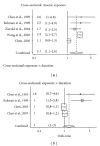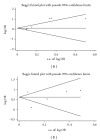The Association between Chronic Arsenic Exposure and Hypertension: A Meta-Analysis
- PMID: 22523484
- PMCID: PMC3317176
- DOI: 10.1155/2012/198793
The Association between Chronic Arsenic Exposure and Hypertension: A Meta-Analysis
Abstract
Background. There is inconclusive evidence from cross-sectional and cohort studies that arsenic exposure is a risk factor involved in the development of hypertension. Methods. A database search, using several keywords, was conducted to identify relevant studies. Separate odds ratio estimates for arsenic exposure with concentration only and arsenic exposure with duration, including biomarker, were extracted from studies that met all inclusion criteria. The extracted odds ratios (OR) comparing the highest exposure categories with the lowest in each study were pooled using the random effects methods of meta-analysis. Heterogeneity of odds ratios in the included studies were analyzed using I(2) statistics. Results. Eight studies were analyzed. Using the exposure as arsenic concentration in the drinking water, the OR estimate was 1.9 (95% CI: 1.2-3.0), with the I(2) = 92%, while using the exposure as concentration and duration, the OR estimate was 1.4 (95% CI: 0.95-2.0) with the I(2) = 80%. Meta-regression was done and the quality of exposure measurement was found to be significantly associated with the effect measure. For a one unit increase in the score from exposure assessment, the odds ratio decreased by 6%. No publication bias was evident. The only major weaknesses of this study were heterogeneity across studies and small sample size. Conclusions. The study findings provide limited evidence for a relationship between arsenic and hypertension. In summary, the relationship between arsenic exposure and hypertension is still inconclusive and needs further validation through prospective cohort studies.
Figures



References
-
- NRDC. Arsenic in drinking water. Natural Resources Defence Council, 2009 http://www.nrdc.org/water/drinking/qarsenic.asp#health.
-
- Chiou HY, Huang WI, Su CL, Chang SF, Hsu YH, Chen CJ. Dose-response relationship between prevalence of cerebrovascular disease and ingested inorganic arsenic. Stroke. 1997;28(9):1717–1723. - PubMed
-
- Abernathy CO, Thomas DJ, Calderon RL. Health effects and risk assessment of arsenic, a supplement at the 11th international symposium on trace elements in man and animals. The American Society for Nutritional Sciences Journal of Nutrition. 2003;133:1536S–1538S. - PubMed
-
- Wang CH, Chen CL, Hsu LI, et al. Chronic arsenic exposure increases mortality from ischemic heart disease and stroke: a follow-up study on 26,851 residents in Taiwan. 2005.
LinkOut - more resources
Full Text Sources
Miscellaneous

